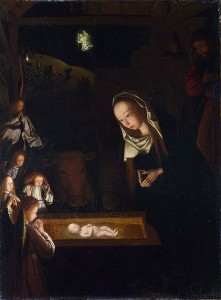 Here at last is Dunstan Thompson‘s Here at Last Is Love. It’s been a group effort to get this slim volume published. Author Gregory Wolfe, California poet laureate Dana Gioia, Thompson’s longtime companion Philip Trower, and others have rescued the poet from oblivion.
Here at last is Dunstan Thompson‘s Here at Last Is Love. It’s been a group effort to get this slim volume published. Author Gregory Wolfe, California poet laureate Dana Gioia, Thompson’s longtime companion Philip Trower, and others have rescued the poet from oblivion.
Thompson (1918-75) was an American poet who had risen to fame in the New York literary scene of the 1940s. After his wartime experience, he all but disappeared in a remote Norfolk village called Cley. His poetry was no longer sought after and published. The problem was, as Dana Gioia wrote, that there were two Dunstan Thompsons: the poetry of early Thompson of the 1940s is “expansive, ornate, dramatic, and confessional.” The later poetry is “austere, urbane, controlled, and quietly confident.” (I’ve written about Gioia’s essay, “Two Poets Named Dunstan Thompson,” which is now the afterword of the book, here.)
According to Kevin Prufer, co-editor of Dunstan Thompson: On the Life and Work of a Late American Master: “Here, for the first time, Gregory Wolfe draws draws poems from the poet’s entire writing life, including his harrowing, erotic wartime poetry and his almost entirely unavailable, more reflective work of maturity. In doing so, he brings to new audiences the work of an essential mid-century poet…”
Greg Wolfe, the book’s editor, has written a graceful introduction to this small volume (128 pages), but this commonplace sentence is the one that stopped me. It describes the poet’s life in rural Norfolk: “A steady stream of visitors – British and American – came to Cley. Thompson’s Harvard friend Billy Abrahams came for many visits along with his partner, the writer Peter Stansky.” Could there be two literary Peter Stanskys in the world, I wondered?
Naturally, I wrote Stanford’s Orwell scholar, Peter Stansky, right away to clear things up. He replied within an hour or so: “Many visits is an exaggeration. The first I remember fairly well, and we may have gone a second time. Dunstan was a contemporary of Billy’s at Harvard and one of his closest friends. Dunstan had gone to England as a soldier during the war and may not have come back to the U.S.A. except briefly, but I’m not sure of that. If so, Billy would have seen him in New York after the war.
“I met Billy in 1961 and some years after that we went to England to work on Journey to the Frontier. We went to see Dunstan and his partner Philip Trower, a very nice Englishman and writer. Dunstan who had been, I believe, a rather irreverent poet had now become a devout Catholic and Philip had converted. We had a very jolly time but I can’t remember much in particular. I bravely swam in the sea. We ate and drank well. They took us to Houghton, the great Norfolk Walpole house, where we were shown around by the Marchioness of Cholmondeley [that would be the former Sybil Sassoon, cousin to the poet Siegfried Sassoon]. Philip had been at Eton with her son.”
“Little did I know that years later after her death I would write her biography [i.e., The Worlds of Philip and Sybil (2003)], so in retrospect, it was terrific that I had met her. I have a feeling that we may have visited a Catholic English shrine at Walsingham. The main point was for Billy and Dunstan to talk about the old days. They may have been somewhat wild, although I don’t remember anything specific mentioned,” he said.
“Billy remained in touch with Dunstan, though I don’t think either were good correspondents. It was very touching that on Dunstan’s death, he left Billy his Bulova watch, some books including, I think, an early edition of Byron I have somewhere and, most wonderfully, he very kindly left me specifically a print by Paul Nash, an artist I much admire that I have on my walls.”
Peter Stansky also gave Dana Gioia several books that Dunstan had inscribed to Billy Abrahams. The Stanford Libraries printed a selection of Abraham’s poems to commemorate Peter’s donation of Abrahams’ papers to Stanford.
The title poem is, as Greg notes, a short “shape poem” called “On a Crucifix”:
See
Here at last
Is
Love.
 It’s one of the last poems in the volume. In keeping with the season, here’s Thompson’s short “Fragment for Christmas,” another poem from the very late Thompson:
It’s one of the last poems in the volume. In keeping with the season, here’s Thompson’s short “Fragment for Christmas,” another poem from the very late Thompson:
.
Dear Lord, and only ever faithful friend,
For love of us rejected, tortured, torn –
And we were there; who on the third day rose
Again, and still looks after us; descend
Into each wrecked unstable house; be born
In us, a Child among Your former foes.
Tags: "Dana Gioia", Billy Abrahams, Dunstan Thompson, Gregory Wolfe, Marchioness of Cholmondeley, Paul Nash, Peter Stansky, Philip Trower, Siegried Sassoon, Sybil Sassoon

